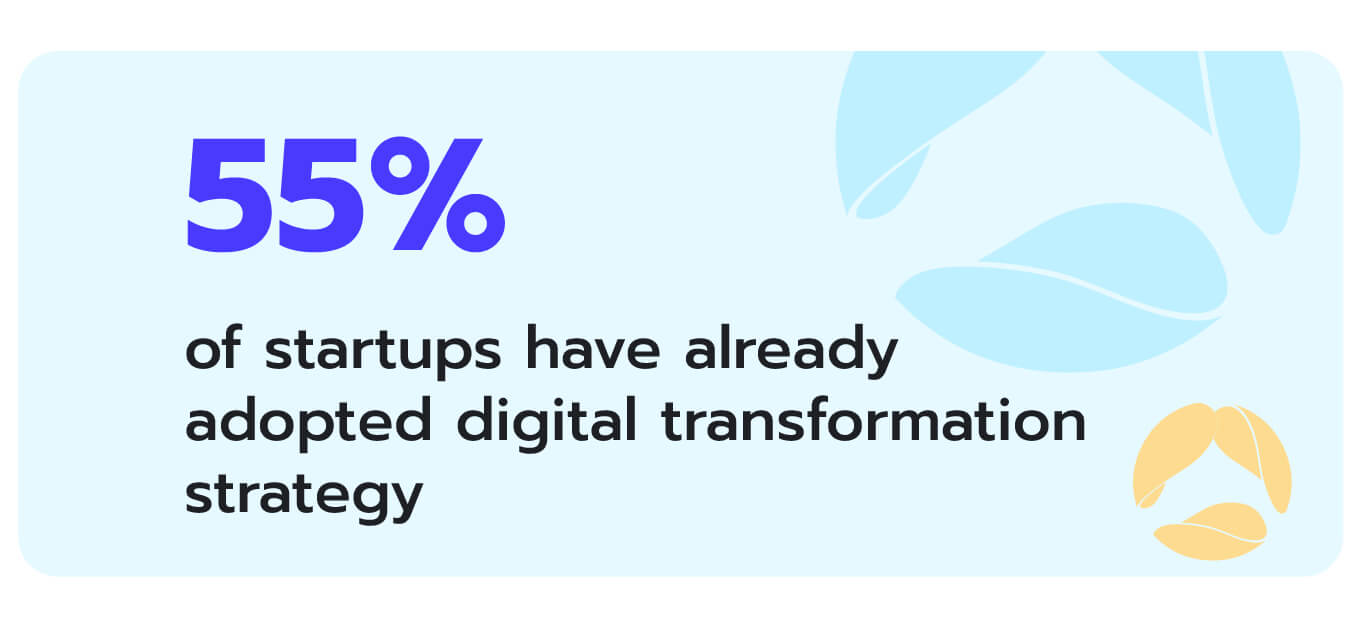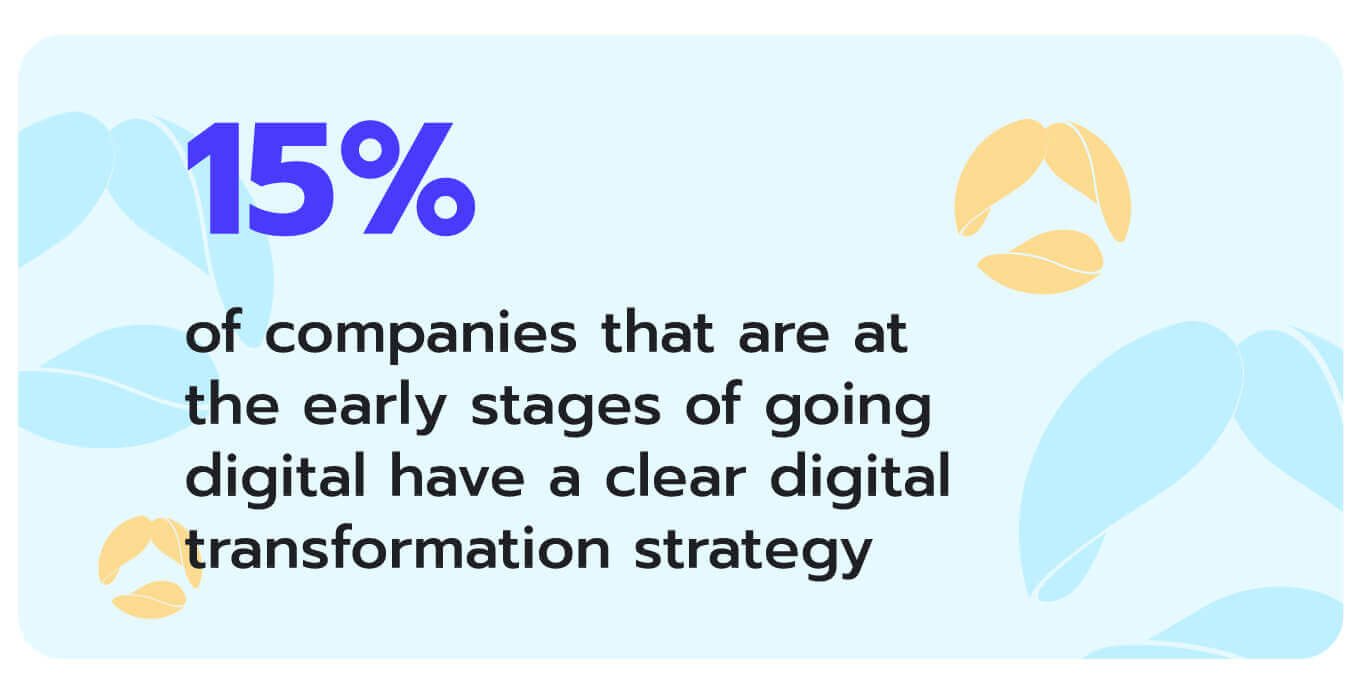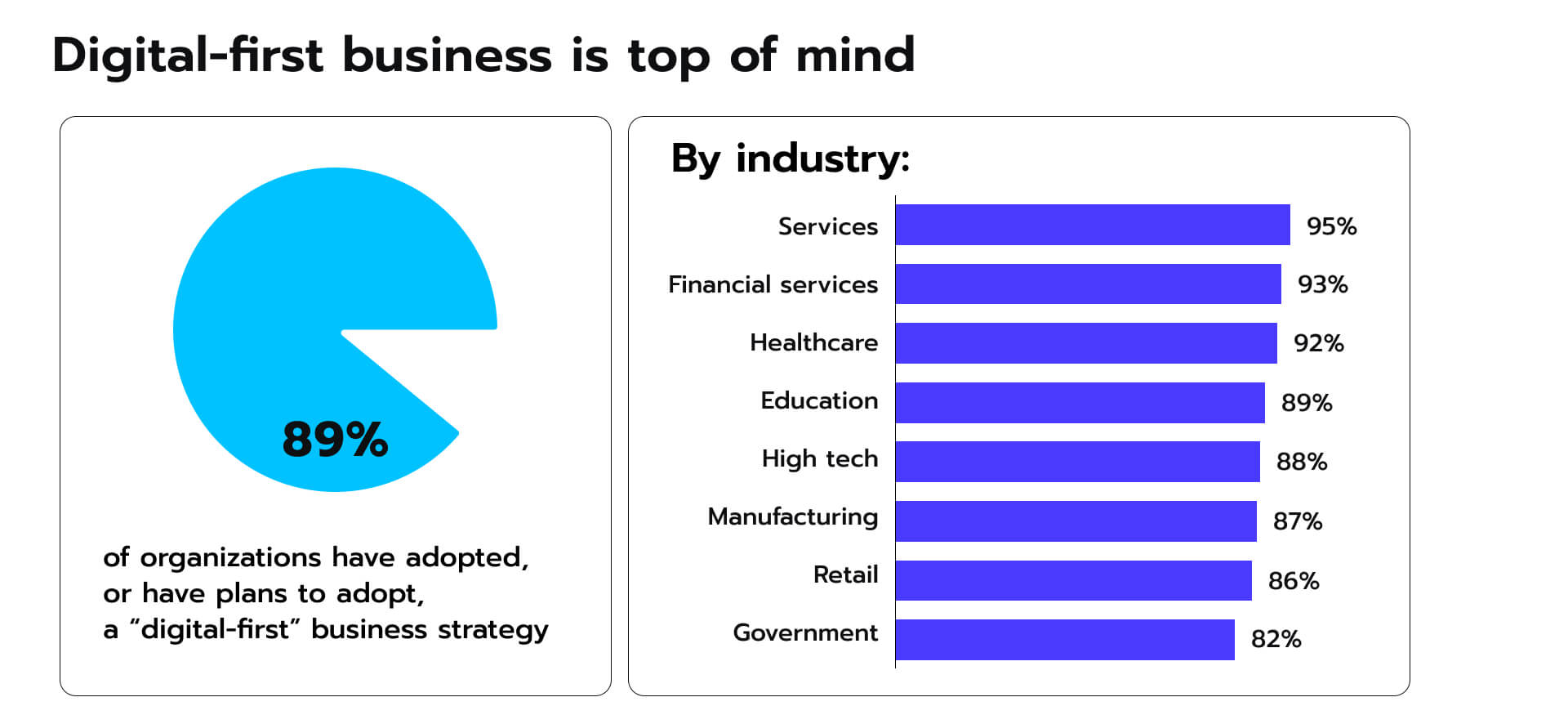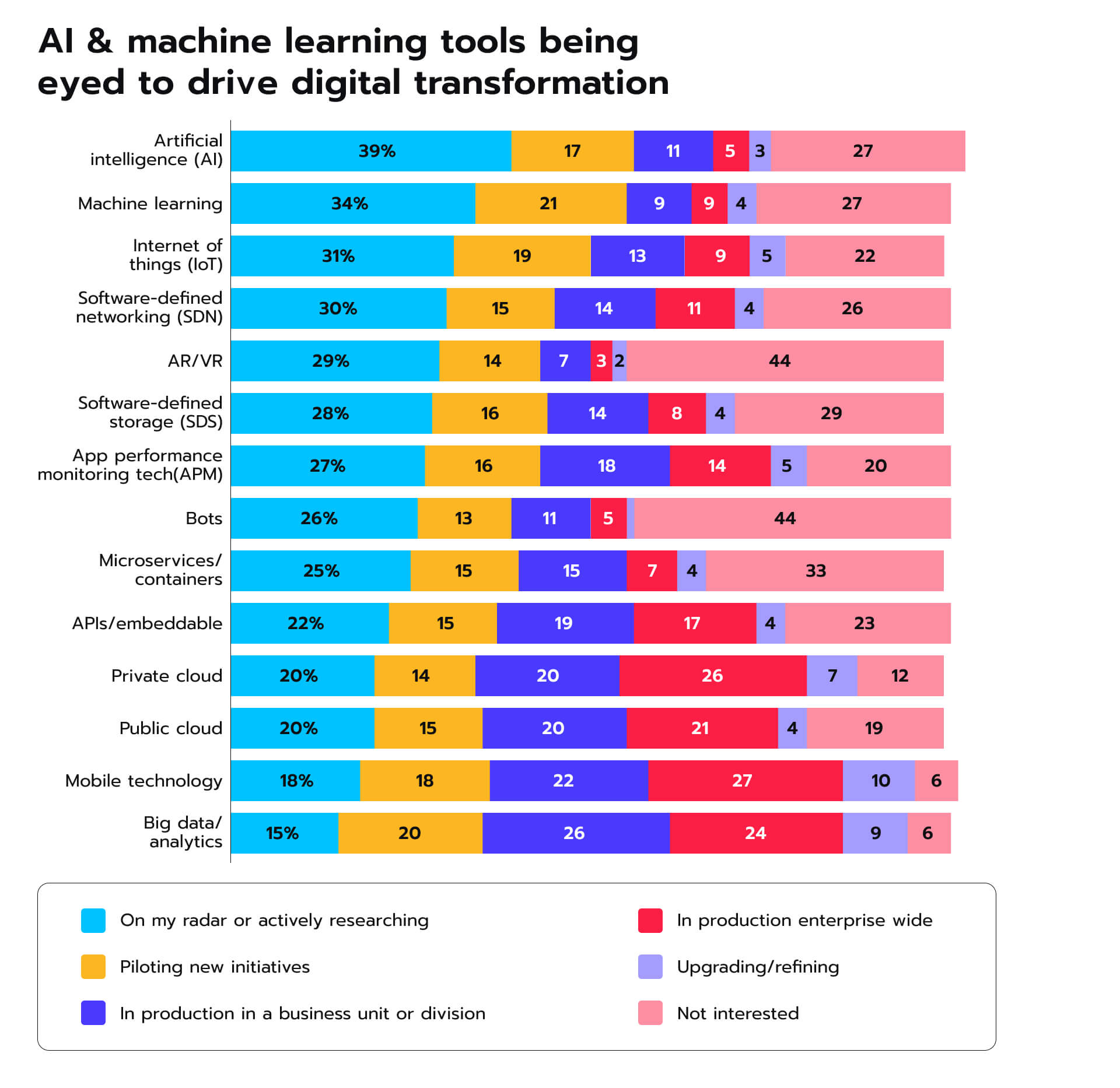Top Fintech trends 2025: The roadmap to smarter financial solutions
Embrace the top fintech trends 2025: from embedded finance to Amazonization, learn how financial service companies make smart decisions for a better future.

Digital transformation as a strategic approach to business growth and innovation.
Today ‘digital’ is the talk of the town. We hear about digital technologies, digital transformation journeys, data, digital media, digital transformation strategies, and digital marketing. Everyone wants to go digital. But which way to go? And what is digital transformation, and why having a digital transformation strategy is essential?
We know now that mobile is the future of everything. Our lives and habits have changed with the rise of the Internet of Things and mobile devices. Everything is now connected; if it’s not, it’s about to. We live in a world where you can connect your coffee machine to the Internet and make your coffee via Bluetooth. If your coffee machine can go online and you’re still only thinking about it, what does it say about you?
Business leaders often view digital transformation as implementing digital technologies into all business areas to build more sustainable relationships and using customer data to understand customers’ needs better. But this is just one of the ways to look at it. When discussing successful digital transformation, we can think of discovering new frontiers and using innovation and technologies to push your business forward. It’s about finding new possibilities for existing services to design and deliver a better experience for your customer. Some might argue it’s a new way of interacting with customers. None of these definitions is more accurate than the other, but what we can all agree on is that today [Tweet “digital transformation is the force that moves businesses forward.”]
But this is just one of the ways to look at it. When discussing successful digital transformation, we can think of discovering new frontiers and using innovation and technologies to push your business forward. It’s about finding new possibilities for existing services to design and deliver a better experience for your customer. Some might argue it’s a new way of interacting with customers. None of these definitions is more accurate than the other, but what we can all agree on is that today [Tweet “digital transformation is the force that moves businesses forward.”]
What is the logic behind going digital? Among the most popular reasons are: Now that we’ve established the significance of data analysis in the digital transformation process, let’s dwell on how crucial it is to plan and strategize.
Strategy is more critical to the digital economy than technology. Simply going digital isn’t going to cut anymore. Only 15% of respondents from companies in the early stages of going digital say that their company has a clear digital business transformation strategy. While for digitally mature companies, where digital-first has already helped transform business models and business processes, and operational efficiency as well as increase talent engagement, the number is more than 80%. Being a digital company is a crucial factor in business and revenue growth and outcomes in many respects today. Potential employees name being digitally enabled company as one of the reasons to seek employment within the organization.
Being a digital company is a crucial factor in business and revenue growth and outcomes in many respects today. Potential employees name being digitally enabled company as one of the reasons to seek employment within the organization.
For companies, a digital business strategy is viewed as means of transforming their operating and business models, streamlining processes, and using technologies to enhance their interaction with customers and employees and deliver excellent customer experience simultaneously. Failing to plan in that field comes with a great price. One of the biggest obstacles to becoming a digitally mature company is the need for an effective digital transformation strategy. Half of the survey participants named it the main barrier to digital maturity.
And what is the state of digital transformation initiatives? The latter is leading in a race between enterprises and startups. 55% of startups have already adopted serious digital transformation initiative or strategy; by contrast, only 38% of traditional enterprises did. But this doesn’t mean that the race is over. Among the established organizations, the wind of change is blowing heavily, with 89% of companies either already adopting or planning to adopt a digital-first business strategy, with Services (95%), Financial Services (93%), and Healthcare (92%) at the forefront (see Fig. 1). Figure 1. State of Marketing Report 2023
Figure 1. State of Marketing Report 2023 At this point, you might wonder why to go all the trouble. Sit back as we tell you the stories about the importance of these digital transformation software development projects.
At this point, you might wonder why to go all the trouble. Sit back as we tell you the stories about the importance of these digital transformation software development projects.
But this is a theory – the best way to draw your organization’s digital transformation and inspiration is to learn from masters like Amazon, one digital company that conquered the retail world.
Ten years ago, nothing suggested a threat to the business value of brick-and-mortar stores. Their future seemed bright and promising. In 2005, Amazon was just an online bookstore with modest sales numbers. Today it is worth more than all major brick-and-mortar stores in the United States combined.
While all of the listed retail stores witnessed a loss in value, going as dramatic as 86-96%, the new digital business models, for Amazon were only blooming. It has gained 1,934% in value and went straight to one of the most valuable companies in the world.
So it’s either nothing predicted a storm or brick-and-mortar stores failed to notice all the warning signs on their way.
Some serve as cautionary tales. Take Kodak, a company that squandered every digital opportunity it had. And plenty it had. It was a Kodak engineer who invented a digital camera back in 1975. And their initial reaction was that it would be a threat to their primary business – film. Instead of seeing the bigger picture, that they are in the storytelling business, Kodak thought they could conquer the new digital technology with a good marketing strategy. The problem with Kodak was not that they failed to go digital; they were unable to adapt to the digital age and the new needs of their customers.
Do you still think your business model is too conservative and doesn’t need digital transformation? Here’s an example from another old-fashioned industry that has recently gone online–a tattoo. Inkbay is a Swedish startup launched in 2016 to help people find and book a tattoo parlor online. Many may argue that tattooing belongs offline, that one of the reasons why it’s become so popular is that it’s something you can’t get on the Internet. But the numbers say the contrary. Inkbay initially linked studios in Stockholm, Malmo, and Gothenburg. It now holds 60 studios on its platform, only to expand to London this summer and Berlin and a $1 billion market soon to follow.
Your business is doing just fine offline today. Either because your industry is quite conservative or you’ve been using other means to get the word out. But what about tomorrow? In the quickly changing world, will what you are doing today be enough? The lesson we can learn from the Titans of the new digital business models is quite simple – in today’s world of digital transformation, be an ‘Amazon,’ not a ‘Kodak.’ Learn to think ahead of your customer’s needs rather than operating business models that fail to adapt to the market’s needs. Find a way to deliver today what your customer might need tomorrow.
In the ever-changing market landscape, swift innovation is critical to staying competitive. IoT has opened up new market opportunities. At the same time, the shift towards digital media and the power of big data analytics offers valuable insights into customer behavior and brand perception. Adapting to evolving customer needs is crucial, as ignoring them can lead to obsolescence. Thinking outside the box, like Inkbay, can position you as a frontrunner in your field, creating value where others see impossibility.
The future of marketing lies in embracing change, leveraging the power of IoT and big data, and adapting to customers’ evolving needs. It’s about understanding the bigger picture and being innovative in creating value. As we move forward, thinking outside the box will be a competitive advantage and a necessity for survival and growth in this digital era.
The main takeaway of going digital is if you’re not online, it’s like you don’t exist. But what goes into the process is careful planning and strategizing. Your customers, current or potential employees, are interested in the best possible experiences and opportunities. And digital businesses have no other choice but to be on the lookout and continuously improve digital enterprises to engage and retain them.
Contact us right away to get the best out of a digital transformation strategy. Our experts are there to translate a conventional digital transformation journey into one bringing only the best the phenomenon can offer.
Ready to innovate your business?
We are! Let’s kick-off our journey to success!